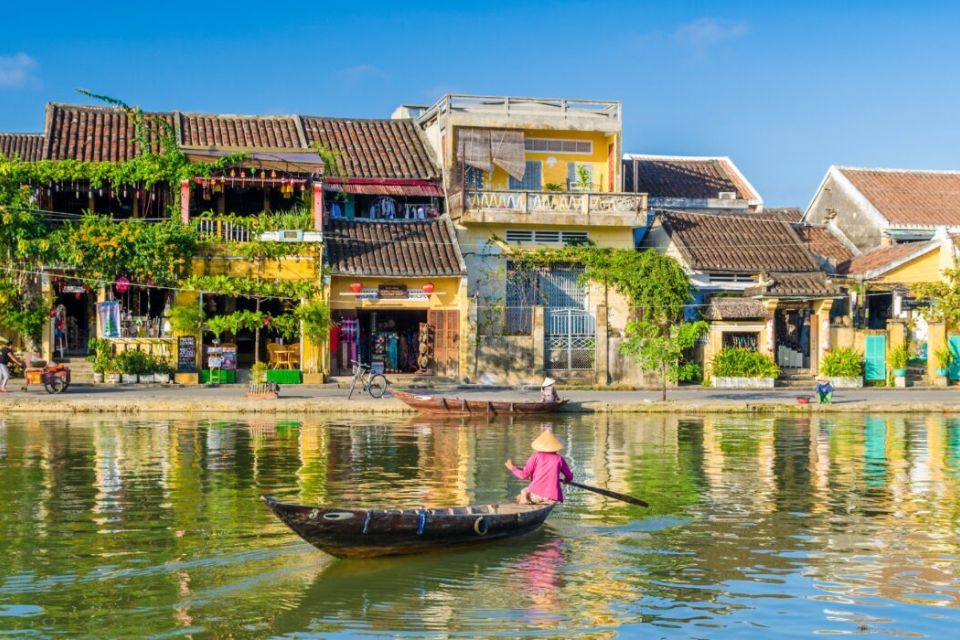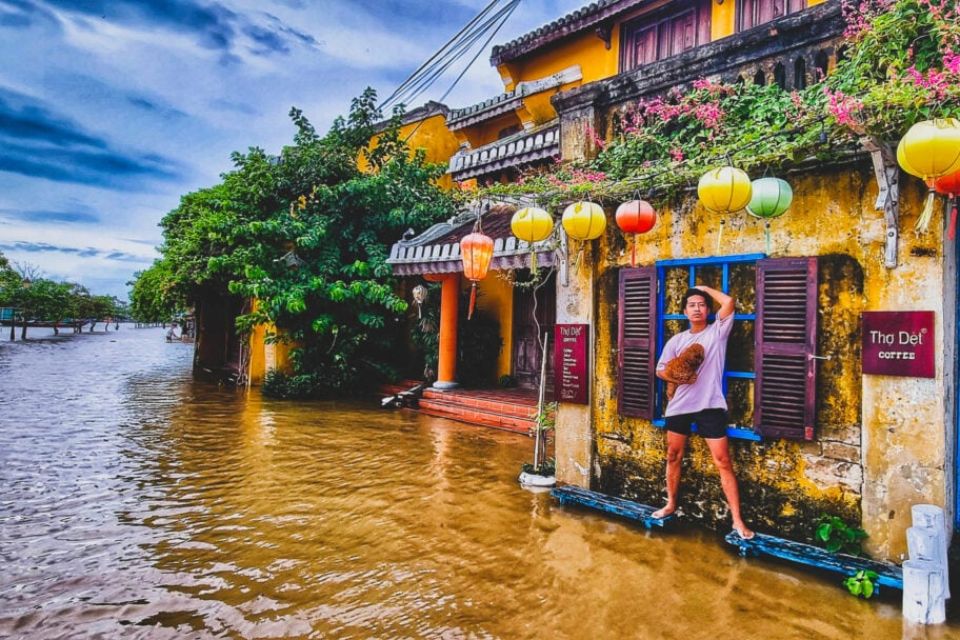
Best Time to Visit Hoi An: A Local's Guide
Hoi An, a UNESCO World Heritage Site in Vietnam, is a charming destination known for its lantern-lit streets, ancient architecture, and vibrant cultural scene. Whether you’re planning to explore the historic town, relax on pristine beaches, or experience the breathtaking Hoi An Memories Show on Hoi An Memories Island, choosing the right time to visit is key to an unforgettable trip. This guide covers Hoi An’s weather by month, the best times to visit, key festivals, and practical tips to help you plan your perfect vacation.
1. An overview of Hoi An's weather
Hoi An enjoys a tropical climate with two main seasons: the dry season (February to August) and the wet season (September to January). Each season offers a unique experience, from sunny beach days to cozy evenings watching the Hoi An Memories Show. Understanding Hoi An’s weather patterns will help you decide when to visit based on your activities, crowds, and budget preferences.
1.1 Hoi An, Vietnam weather in the dry season (February – August)
The dry season is characterized by warm, sunny weather, making it ideal for outdoor exploration and cultural experiences like the Hoi An Memories Show. Temperatures range from 25°C to 35°C (77°F to 95°F), with moderate humidity and minimal rainfall.

Hoi An’s weather is distinctly characterized by two clear seasons: the sunny season and the rainy season
- February to April: Expect mild temperatures (22°C–30°C / 72°F–86°F) and clear skies. This is perfect for sightseeing, cycling through rice paddies, or strolling through Hoi An’s ancient town. Evening performances of the Hoi An Memories Show are delightful in this comfortable weather.
- May to August: Temperatures rise to 35°C (95°F), with hot, sunny days. Beaches like An Bang and Cua Dai are at their peak, and the Memories Show offers a refreshing evening activity under the stars.

Summer in Hoi An is hot and sunny, yet the enchanting scenery continues to captivate countless travelers
1.2 Hoi An's climate in the wet season (September–January)
The wet season brings cooler temperatures (20°C–28°C / 68°F–82°F) and frequent rainfall, especially from October to December. Occasional typhoons and flooding can occur, but the rain adds a magical ambiance to Hoi An’s lantern-lit streets. Indoor attractions, such as the Hoi An Memories Show, are ideal during this period.
- September to October: Rainfall increases, but showers are often brief. Warm days make it possible to explore during breaks in the weather, with the Memories Show providing a sheltered evening option.
- November to January: Expect cooler weather and heavier rain, particularly in November. Flooding may affect low-lying areas, so focus on indoor activities like the Memories Show or visiting Hoi An’s museums and cafes.
2. When is the best time to visit Hoi An?
The best time to visit Hoi An depends on your priorities. For ideal weather and fewer crowds, February to April is the sweet spot, offering mild temperatures and clear skies perfect for exploring the ancient town, beaches, and Hoi An Memories Island. The Hoi An Memories Show, a cultural spectacle showcasing Vietnam’s history through dance and visuals, is a highlight during this period.

Hoi An always has unique highlights that leave a lasting impression on visitors throughout the year
If you’re drawn to festivals, consider visiting during the Hoi An Full Moon Lantern Festival (monthly) or Tết (late January or early February). Budget travelers may prefer the wet season (September to January) for lower prices and fewer tourists, with the Memories Show offering a weather-proof activity. No matter the season, Hoi An’s charm and the captivating Hoi An Memories Show make it a year-round destination.
>>> See more: What makes Hoi An so special
3. Best months to visit Hoi An, Vietnam
Let Hoi An Memories Land guide you through the best months to visit Hoi An, helping you choose the perfect time for your journey. Each season offers a unique perspective on Hoi An’s timeless charm, from vibrant sunny days to serene rainy moments, ensuring an unforgettable experience.
3.1 January to March
Weather: Cool and refreshing (20°C–28°C / 68°F–82°F), with minimal rain and crisp air.
Why Visit: Spring is the ideal time to stroll through the Ancient Town, cycle along lush countryside paths, or visit Cham Island. Cool evenings are perfect for floating lanterns on the Thu Bon River or diving into Hoi An’s vibrant cultural scene. The festive energy of Tết (Vietnamese Lunar New Year) in late January or early February adds a lively touch.
Tip: Book accommodations early, especially during Tết, when Hoi An buzzes with celebrations.
3.2 April to June
Weather: Warm and sunny (25°C–35°C / 77°F–95°F), with little to no rain.
Why Visit: This is the perfect time to bask on An Bang or Cua Dai Beach or wander the Ancient Town under golden sunlight. Activities like getting a traditional áo dài tailored or exploring craft villages such as Thanh Ha Pottery Village are especially rewarding.
Tip: Pack sunscreen, a wide-brimmed hat, and lightweight clothing to stay comfortable in the summer heat.
3.3 July to September
Weather: Hot (up to 35°C / 95°F), with occasional light showers in September.
Why Visit: Summer is peak season for beach lovers, with An Bang Beach offering a stunning escape. The vibrant atmosphere is amplified by the Mid-Autumn Festival in September, when the Ancient Town glows with lanterns, lion dances, and cultural traditions. Light showers toward the end of the season add a refreshing, romantic touch.
Tip: Stay hydrated, apply sunscreen, and plan outdoor activities for early mornings or late afternoons. During midday heat, relax in a cool cafe or visit a museum in the Ancient Town.

An Bang Beach is a must-visit destination when exploring Hoi An
3.4 October to December
Weather: Cool (20°C–28°C / 68°F–82°F), with frequent rain, especially in November.
Why Visit: The wet season brings a serene, poetic ambiance to Hoi An, with fewer tourists and lower prices. The Ancient Town’s timeless charm shines through, with rain-soaked streets reflecting lantern light. This is an ideal time to savor local cuisine, sip tea in cozy cafes, or enjoy indoor cultural experiences like the Hoi An Memories Show.
Tip: Bring a lightweight raincoat or compact umbrella and check weather updates to avoid days with potential flooding.

Heavy rains and light flooding from October to December often bring unexpected surprises for visitors
4. Events and Festivals to Consider
Hoi An’s cultural calendar is alive with events that bring its heritage to life, offering unforgettable moments for every traveler.
4.1 Hoi An Full Moon Lantern Festival – Monthly
On the 14th day of each lunar month, Hoi An’s Ancient Town transforms into a glowing masterpiece. Thousands of lanterns light up the streets, and the Thu Bon River shimmers with floating candles, creating a magical setting for evening strolls and riverboat rides.

The Hoi An Lantern Festival takes place monthly in Hoi An
4.2 Tet (Vietnamese Lunar New Year) – Late Jan or Early Feb
Tết is Vietnam’s most vibrant celebration, filling Hoi An with colorful decorations, traditional foods, and lively performances like lion dances. The Ancient Town hums with festive spirit, making it a joyous time to visit.
4.3 Mid-Autumn Festival – September
This beloved festival illuminates Hoi An with lantern processions, mooncakes, and vibrant cultural displays. It’s a heartwarming opportunity to experience the city’s community spirit and traditions.
4.4 Hoi An Memories Show – Available Year-Round
Performed nightly (except Mondays) at Hoi An Impression Theme Park, the Hoi An Memories Show is a cultural masterpiece, weaving 400 years of Hoi An’s history through breathtaking dance, music, and visuals. With over 500 performers and covered seating, it’s a must-see experience in any weather.
>>> Discover more and book tickets here
5. Tips for Visiting Hoi An Based on the Season
To make your Hoi An journey seamless and memorable, Hoi An Memories Land shares these practical tips tailored to each season, ensuring you experience the city’s charm to the fullest.
5.1 Book Early for Spring and Summer
From April to August, Hoi An’s weather can be hot, with temperatures soaring. Pack lightweight, breathable clothing, along with a hat and sunscreen, to comfortably explore the Ancient Town and beaches like An Bang or Cua Dai.
5.2 Pack Light and Breathable Clothing for Hot Months
From April to August, Hoi An’s weather can be hot, with temperatures soaring. Pack lightweight, breathable clothing, along with a hat and sunscreen, to comfortably explore the Ancient Town and beaches like An Bang or Cua Dai.
5.3 Bring Rain Gear During the Wet Season
From September to January, frequent rain showers are common. A lightweight raincoat or compact umbrella will keep you comfortable while strolling the Ancient Town or enjoying indoor activities like cultural shows or cozy cafes.
5.4 Avoid Weekend Crowds at Full Moon Festivals
The Full Moon Lantern Festival draws large crowds, especially on weekends. For a more tranquil experience, visit midweek to enjoy the festival’s magic in a peaceful setting, allowing you to fully immerse yourself in Hoi An’s serene beauty.
6. Frequently Asked Questions About the Best Time to Visit Hoi An
6.1 What is the best month to visit Hoi An?
February to April is the ideal time to visit Hoi An, with cool, pleasant weather (20°C–28°C / 68°F–82°F), minimal rain, and fewer crowds. This season is perfect for exploring the Ancient Town and enjoying cultural activities in a relaxed atmosphere.
6.2 When is the rainy season in Hoi An?
The rainy season in Hoi An spans from September to January, with the heaviest rainfall occurring in October and November. Indoor experiences, such as savoring local cuisine or attending cultural performances, are excellent choices during this time.
6.3 Is it worth visiting Hoi An during the low season?
It’s well worth it! The low season (September to January) offers more affordable prices, a quieter ambiance, and the poetic beauty of the Ancient Town in the rain. Cultural activities enrich the experience, making it a rewarding time to visit.
6.4 Are the beaches in Hoi An swimmable year-round?
It depends on the season. Beaches like An Bang and Cua Dai are at their best from February to August, with sunny skies and calm seas. During the rainy season, rough waves and wet weather may limit swimming opportunities.
6.5 When is the Lantern Festival held in Hoi An?
The Hoi An Full Moon Lantern Festival takes place on the 14th day of each lunar month. Check the lunar calendar for exact dates and pair your visit with cultural experiences to make your trip truly memorable.
7. Plan Your Hoi An Journey

Let the glowing lanterns of Hoi An and the breathtaking Hoi An Memories Show at Hoi An Memories Land call you to an unforgettable journey
Hoi An is a place where time slows down, inviting you to lose yourself in its lantern-lit streets, ancient charm, and vibrant culture. Whether you visit during the sunny dry season or the poetic wet season, every moment here tells a story. From the magic of the Full Moon Lantern Festival to the captivating Hoi An Memories Show, Hoi An promises memories that linger.
>>> About Accommodation Tips in Hoi An
-
Hotline: 1900 63 66 00
-
Press 1 For tickets
-
Press 2 For Customer Service
Latest news

The Historical Evolution of Hoi An Ancient Town Through the Ages

Where to Stay in Hoi An: Best Areas from Town to Coast

Hoi An Vietnam what to do: 6 Traditional folk games you must try

Top 20+ best places to stay in Hoi An














Comment